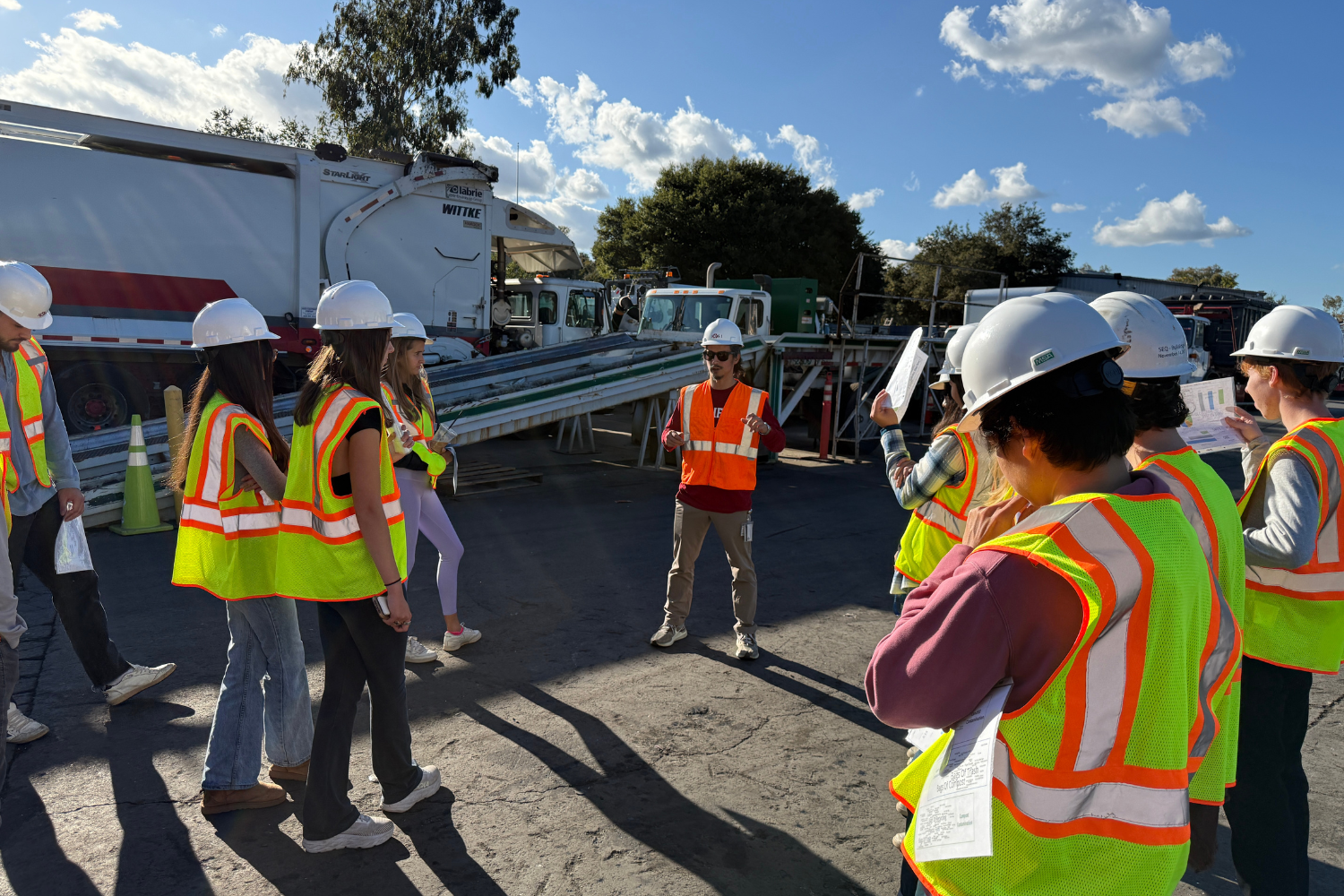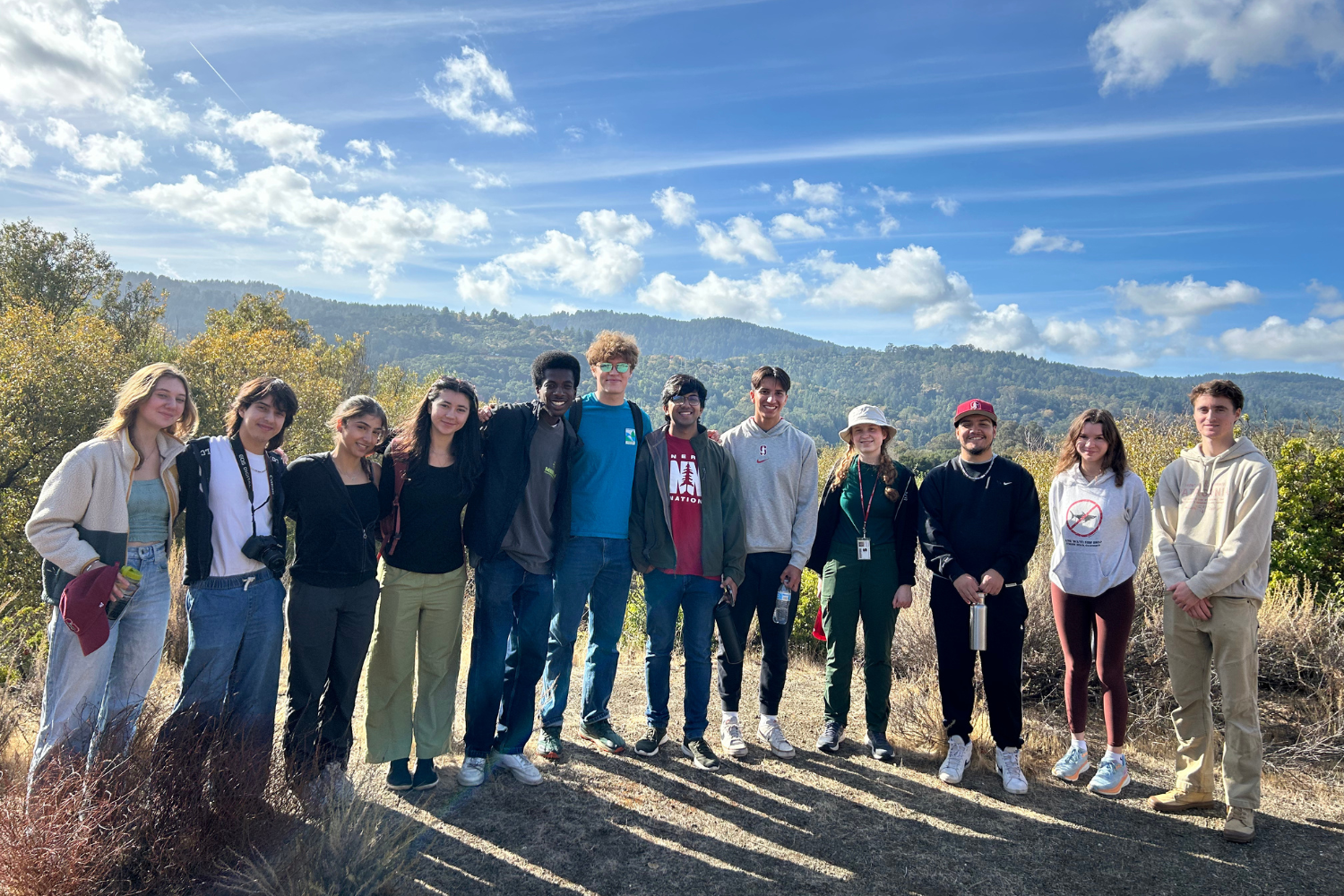As a student in Introduction to Earth Systems, you can expect to sing the “Itsy Bitsy Spider,” hold your own in a debate about environmental solutions, and journey around (or off) campus to see chemical processes, environmental economics, and interdisciplinary innovations in action. Through wide-ranging lectures from renowned scholars, a student-led town hall, and a collection of field trip options, these students delve into the complexities of Earth systems and interconnected human impacts with empathy and critical thinking.
“This is a space that’s specifically catered to people who don’t know much about environmental science or our climate crisis,” said Aiyana Washington, a head teaching assistant for the course and Earth Systems graduate student. “We break down a lot of complex concepts and work to create an enriching and dynamic experience, so I think it’s very approachable for students from any discipline.”
Although it is an introductory course, the questions Earth Systems 10 poses to students are far from simple: How fast is the climate changing? Can a price be put on biodiversity? How are we going to feed 10 billion people? Will coral reefs disappear by 2050? How can we prepare for a future without fossil fuels?
“What I think is unique about EARTHSYS 10 is the blending of science and policy across a broad range of topics that are of concern to many of our students,” said course instructor Kevin Arrigo, the Donald and Donald M. Steel Professor of Earth Sciences and past director of the Earth Systems Program in the Stanford Doerr School of Sustainability. “Our greatest strength stems from our stellar team of teaching assistants that provide the critical connective tissue linking the diverse set of topics covered by our extraordinary slate of speakers.”
In total, 28 Stanford experts came to speak with the students about topics that include Earth history, climate change, oceans, conservation, sustainable food, energy science, and much more. The course is also renowned for its team of teaching assistants – 10 course alums who represent a wide variety of the academic tracks within the Earth Systems Program: sustainable food and agriculture; environmental geoscience; oceans, atmosphere, and climate; biosphere; energy science and technology; human environmental systems; and land systems.
While this is, formally, the introduction to the interdisciplinary Earth Systems major in the Doerr School of Sustainability – which examines environmental problems caused by human activities through the lens of natural sciences, economics, politics, and more – the information and skills it teaches are designed for anyone, regardless of major or interest, and the community the course creates stretches far beyond any individual area of study.
“We want to help educate students to become engaged citizens,” said instructor and environmental scientist Richard Nevle. “Whether the students in the class are going to pursue Earth Systems or whether they are pursuing medicine or business or law or arts or education, we need all kinds of thinkers involved with sustainability problem-solving.”
Three levels of understanding
The course begins by outlining “Earth’s operating system and how the parts of that system interact as a complicated, fascinating, organic machine,” explained Nevle.
“You have lectures by faculty from across the university who are world experts in their fields, talking about each component of the Earth system – whether it’s environmental policy, atmospheric circulation, renewable energy, or environmental justice,” said Nevle, who is deputy director of the Earth Systems Program. “So, we have thought leaders who are talking with students at a level that’s accessible for everyone.”
“I love all the lectures given in EARTHSYS 10, but the moment that I always look forward to is Tom Hayden [director of the Master of Arts in Earth Systems, Environmental Communication Program] leading the class in a rousing rendition of ‘Itsy Bitsy Spider,’” said Arrigo. “It is a great example of the importance of storytelling as a tool to increase students’ retention and empathy.”
The second focus of the course is the human element: how people interact with and affect the Earth system and the challenges that it’s creating for maintaining a habitable biosphere. The third component is focused on how we might remediate some of those human-made environmental problems.

While at the recycling center Peninsula Sanitary Service Inc., students learned about the importance of proper waste management and the realities of recycling and zero waste goals. | Vivian Shay
“As a teaching team, we do our best to present facts while also imbuing them with empathy and principles of justice,” said Washington, who shared head teaching assistant duties with fellow graduate student Page Proctor. “We want students to gain an appreciation for the natural world but to also be critical of the way that our institutions and Western scientific practices approach the human-environment relationship.”
A legacy of teaching and learning
With a history spanning nearly 30 years, Earth Systems 10 leverages its legacy. The teaching assistants are alums of the course, many of the guest lecturers return year after year, and some of the current instructors, including Arrigo and Nevle, were previously involved as guest lecturers.
“There’s a deep synthesis that happens through the older generation of scholars who are teaching the lectures and young teachers who are learning how to lead a section and getting to relate and connect with these students,” said Nevle.
Although there are many aspects of Earth Systems 10 that are memorable, the course is perhaps best known for the teaching assistant team, which runs seminars each week to deepen understanding and connections with the course material.
“The TAs play a huge role in not just creating homework assignments and exams but also connecting the content to our students and highlighting aspects of the material that resonate with each of us,” said Washington. “There’s a lot of care put into the curriculum, and it’s designed to be supportive and empowering.”

Students ventured to Stanford’s Jasper Ridge Biological Preserve ('Ootchamin 'Ooyakma) to experience ecosystems of the Bay Area, learn about human history from the Muwekma Ohlone onward, and witness current environmental research happening at the preserve. | Aiyana Washington
The TAs also coordinate a series of field trips throughout the quarter designed to give students hands-on experience with Earth systems and sustainability. Last quarter students could visit the O’Donohue Family Stanford Educational Farm, Jasper Ridge Biological Preserve ('Ootchamin 'Ooyakma), Hopkins Marine Station, Peninsula Sanitary Service Inc., or the Stanford Energy System Innovations Central Energy Facility.
Lastly, the TAs oversee the week 8 town hall, where students take on the roles of different stakeholders – such as scientists, landowners, ranchers, or members of tribes – and are tasked with navigating a particular environmental challenge in negotiation with the other stakeholders.
“The town hall gives students a chance to see how contentious and complex and messy the process of problem-solving is,” said Nevle.
A classroom community
As happens in the best introductory courses, Earth Systems 10 creates a unique sense of community. It’s a place where students are encouraged to engage enthusiastically with the expert guest lecturers and field trip guides, and where they inevitably make lasting memories with their classmates and TAs.
While applying for her TA position, Washington reached out to her own Earth Systems 10 teaching assistant – an experience she described as a “full-circle moment.”
“It was wild to realize not only the impact that she’s had on my time at Stanford, but the impact that her students have had on her,” said Washington. “Beyond this course being an important introduction to Earth sciences, it’s also such a special space for students to connect with each other.”
The lessons and experiences from this course are designed to be personally and professionally meaningful, regardless of where students’ journeys take them next.
“Our goal for the course is to inspire the students to think more holistically about our planet and how humans interact with it,” said Arrigo. “We want them to understand not just the ‘what’ but also the ‘why’ and ‘how’ of a diverse set of topics.”
For more information
Arrigo is also a professor of Earth system science, a senior fellow of the Stanford Woods Institute for the Environment, and a member of Stanford Bio-X.